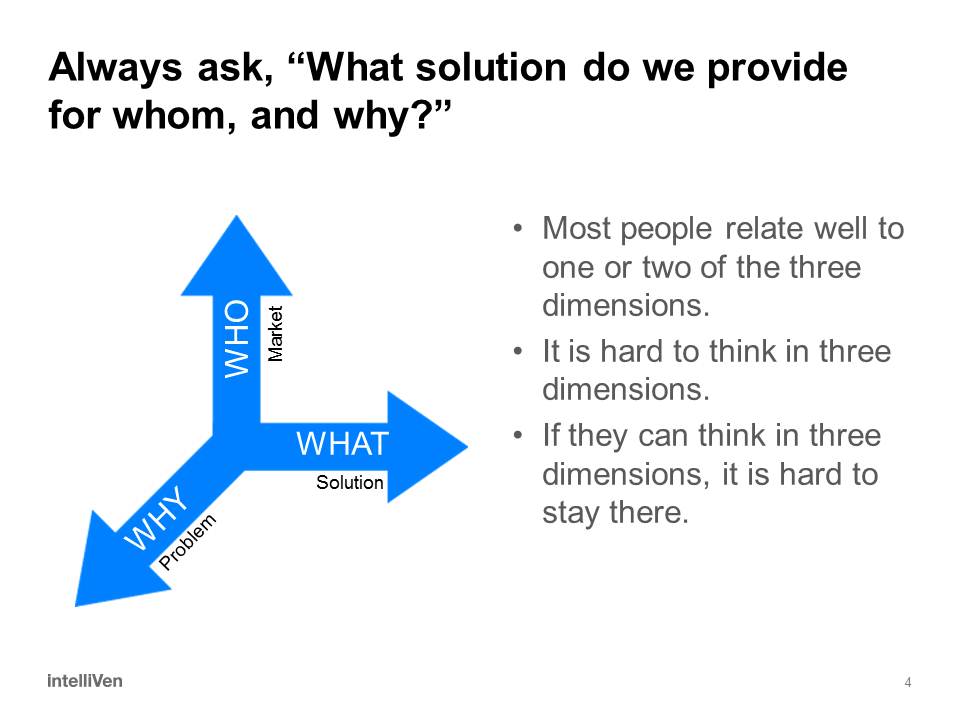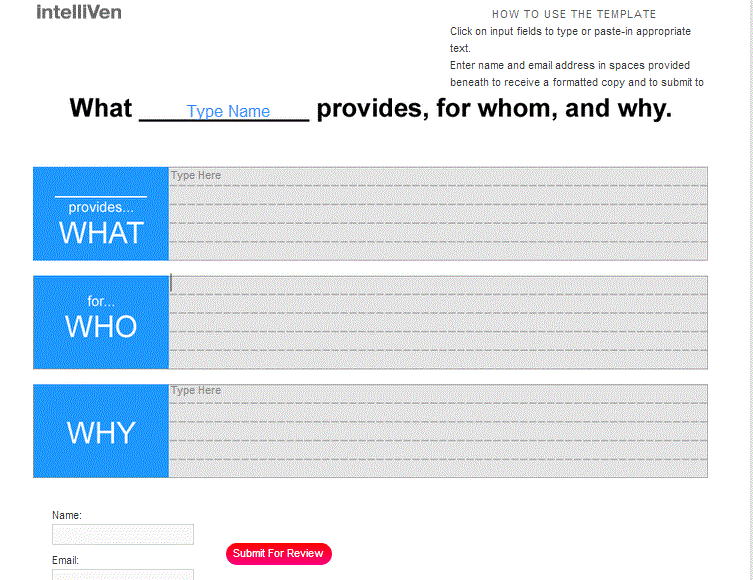The purpose of a business is to solve a problem for a customer…which begs this question:
WHAT solution does your organization provide to
WHO and
WHY do they pay for it?
A way to think about it is that there are three dimensions to any business: WHAT, WHO, and WHY or in terms of Market (WHO), Problem (WHY), and Solution (WHAT).
Leaders tend to describe their organization in terms of one or two, but rarely all three, dimensions. The reason may be because thinking about any three things at the same time challenges the mind. If anyone does think three completely different things all at once, it is hard to do it for any length of time.
The 2:56′ video above uses the graphic below to present a way to visualize an organization in terms of the problem it solves (or WHY anyone needs what the organization provides), for WHO (market), and withWHAT(solution):
Any organization can use the template linked to the graphic below to lay out its three defining dimensions: 
While it may at first seem simple, it is usually surprisingly difficult for leaders to sort out all three dimensions. When a team of leaders each fills out the template on their own and then compare input, it is enlightening to see how different their responses are and how valuable it is for the team to agree on a single, consolidated way to articulate their WWW.
Furthermore, leaders who conduct an All Hands survey to find out what is on the minds of their employees usually discover that the most urgent need across the board is to know more about: “Who are we and what do we do?”
Often, the problem is that top leaders may be clear about one or two of the three dimensions but few realize that it is vital to be clear about all three. When leaders know and articulate whose problem their organization solves, it helps everyone individually, and collectively, to perform better.
Organizations that have developed a purpose, mission, vision, and/or “elevator pitch” may already have already answered the question: “Whose problem do we solve?” If they have not, they should.
Most top teams find that it takes several hours over many work sessions over several months, up to a year or more, to complete the process. It is worth the trouble for those that do. The resultant clarity and alignment pave the way for peak performance.
To illustrate, consider an organization that helps:
- Credit card companies (i.e., the market or WHO)
- Increase efficiency of delinquent account collections (i.e., the WHY or problem addressed by the solution) by hosting a
- Cloud-based automated collection utility (i.e., the solution or WHAT is provided).
An organization that has two of the three dimensions the same and a different third, might define an entirely different organization. For example, the same cloud-based automated collections system that improves collection efficiency (i.e., the same problem) for a different market (say, state income tax collection departments) might define an entirely different organization because the market served by one organization (credit card companies) is so vastly different than the market served by the other (state income tax collection departments).
Yet another organization might provide a packaged software system that is delivered, installed, run, and maintained in-house, rather than a cloud-based solution, to address the same problem for the same market. Such a different solution would almost certainly be provided by a different organization because it would be unduly difficult and complex for a single organization to do a good job providing both solutions even though the market and problem are the same as the other.
While varying any one of the three dimensions may define a separate organization, a new organization can also emerge from another. An organization that serves credit card collections departments can expand to focus on state income tax collections departments and/or on telecommunications billing collections and others, for example.
It would make sense to set up different organizations for each market because for a single organization to approach and serve more than one market requires a breadth of skills and resources that can be overwhelming to manage. Trying to pursue multiple markets out of one organization would likely cause it to under-perform relative to its potential and relative to its peers.
SEE ALSO
How to decide what problem to solve.
Click, fill-out, and submit a WWW for your organization using the template linked to the graphic above.




I have been working with IntelliVen for approximately 10 years. I cannot tell you just how powerful this exercise is for the companies and divisions that I have worked in.
The clarity and alignment coming out of this process positively impacts my business for years.